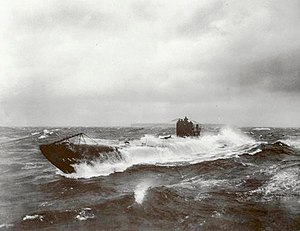 UB-148 at sea, a U-boat similar to UB-50.
| |
| History | |
|---|---|
| Name | UB-50 |
| Ordered | 20 May 1916[1] |
| Builder | Blohm & Voss, Hamburg |
| Cost | 3,276,000 German Papiermark |
| Yard number | 295 |
| Launched | 6 January 1917 |
| Commissioned | 12 July 1917 |
| Fate | Surrendered 16 January 1919; broken up at Swansea[2] |
| General characteristics [2] | |
| Class and type | Type UB III submarine |
| Displacement | |
| Length | 55.30 m (181 ft 5 in) (o/a) [2] |
| Beam | 5.80 m (19 ft)[2] |
| Draught | 3.68 m (12 ft 1 in)[2] |
| Propulsion |
|
| Speed | |
| Range | |
| Test depth | 50 m (160 ft) |
| Complement | 3 officers, 31 men[2] |
| Armament |
|
| Service record | |
| Part of: |
|
| Commanders: | |
| Operations: | 7 patrols |
| Victories: | |
SM UB-50 was a German Type UB III submarine or U-boat in the German Imperial Navy (German: Kaiserliche Marine) during World War I. The U-boat was ordered on 20 May 1916. She was commissioned into the Pola Flotilla of the German Imperial Navy on 12 July 1917 as SM UB-50.[Note 1]
The submarine conducted seven patrols and sank 40 ships during the war for a total loss of 97,922 gross register tons (GRT) and 16,499 tons. She operated as part of the Pola Flotilla based in Cattaro. UB-50 surrendered on 16 January 1919 with the remainder of the Pola Flotilla following an order by Admiral Reinhard Scheer to return to port. During her passage through the Straits of Gibraltar, she managed to sink the battleship HMS Britannia. UB-50 was later broken up at Swansea.[2]
Cite error: There are <ref group=Note> tags on this page, but the references will not show without a {{reflist|group=Note}} template (see the help page).